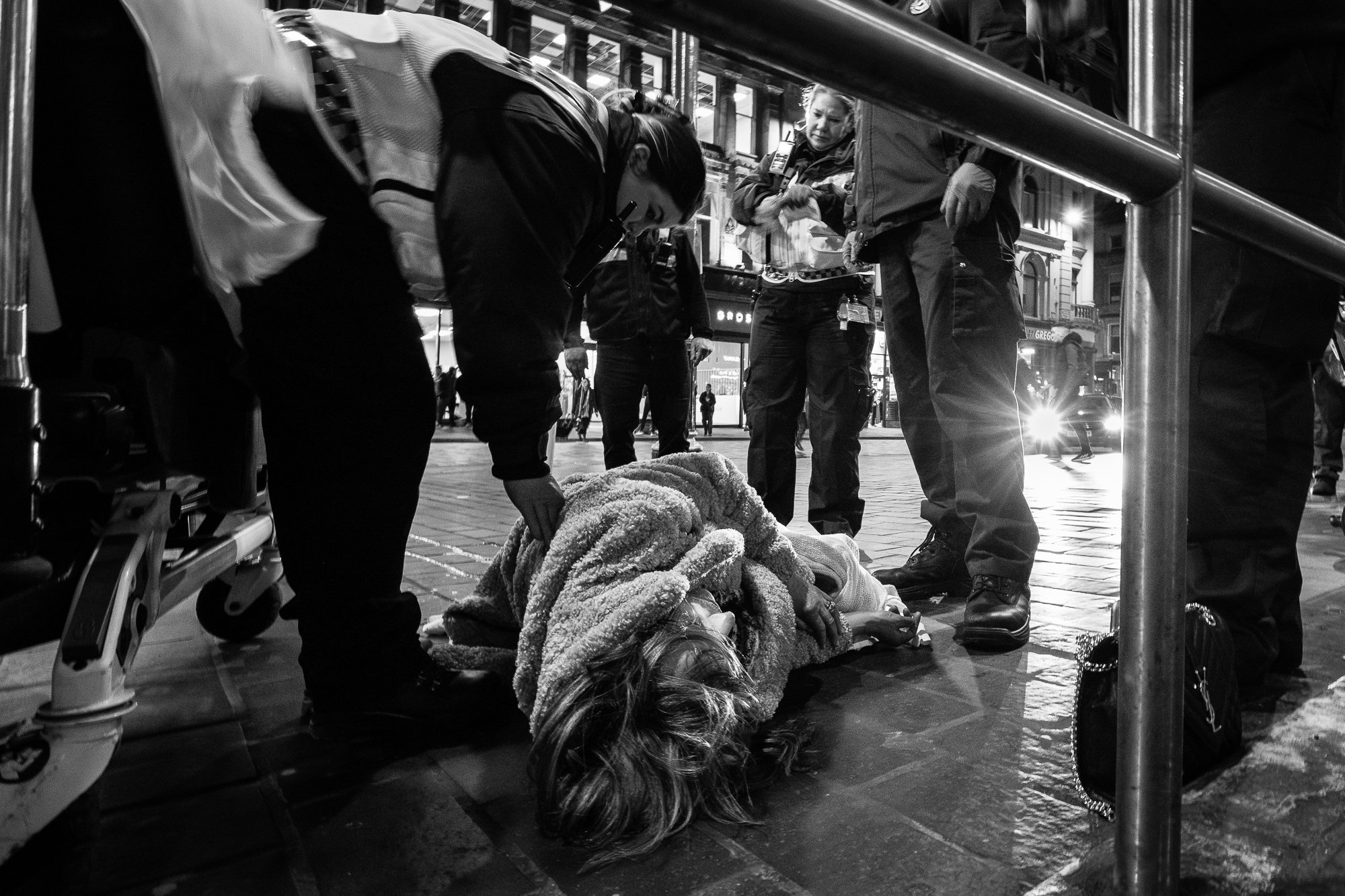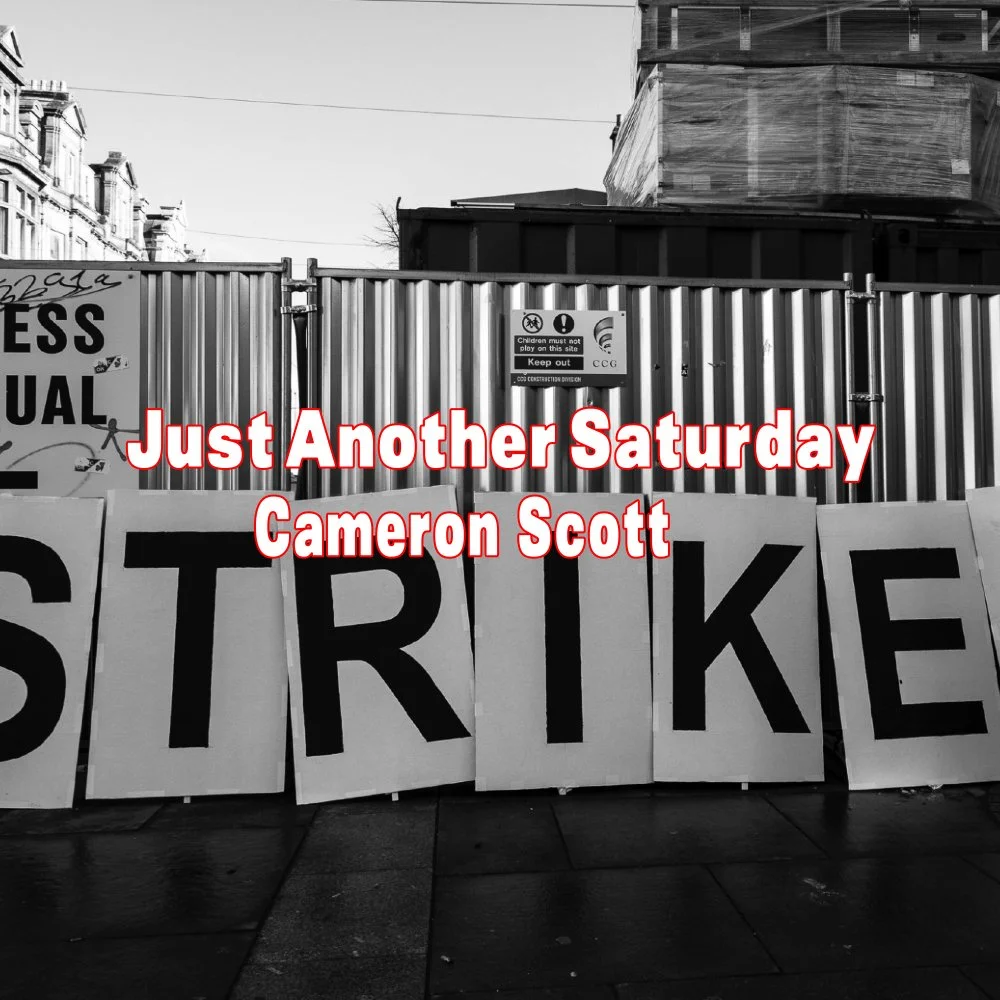Recording the life at hand through photography
Glasgow Street Aid
It’s after 11pm on a Saturday night in Glasgow city centre. There is a noisy and potentially hostile crowd gathering either side of me. In front of me crew members from Glasgow Street Aid frantically treat a young woman who has just had a toxic substance thrown in her face. John, assisted by Alison and some other crew members, is spraying her face with water, paying particular attention to her eyes while she screams in pain. I am photographing this drama as it unfolds without thinking as the toxic substance, which we now know to be ammonia, is washed onto the pavement and around our feet. Eventually the Police arrive and tape off what is a crime scene. I am allowed to remain inside although I have already got the images that I need so I move back. The Fire and Ambulance service arrive shortly after, and the street is eventually closed as this develops into a full-blown hazardous substance incident. So ends my first session documenting the remarkable work carried out by Glasgow Street Aid.
In August 2023 I received an email from a representative from Glasgow Street Aid (GSA), a charity set up and staffed by medical professionals whose aim is to provide first response assistance to those in need in Glasgow city centre during weekend nights. The request seemed fairly straightforward. The representative, Alison, who is the charity’s Special Projects lead, had managed to get the GSA building accepted into Glasgow’s upcoming Doors Open Exhibition and she was looking for someone with street photography experience to take a few pictures of the medical crews in action. Being a small charity there was no budget for this, however there was the promise of home baking, so that was enough to get me interested.
Glasgow Street Aid were not unfamiliar to me at this stage. They have their own private ambulance which was occasionally parked outside their medical welfare centre in the heart of the city, which I had passed on many occasions. However, the sheer scale of their operation was something that was unknown to me, but was to become apparent as this project unfolded over the course of the next year. As a charity they rely on donations and fundraising to finance their operations and yet they provide vital services normally reserved for the ambulance service and accident and emergency departments at hospital, annually preventing thousands of cases impacting the wider National Health Service.
After initial introductions we agreed on the way forward. I only work in black and white, so that was fine. I was asked to take candid images of the two-person crews in action, either treating service users or just generally interacting with the public but taken in such a way that any service users could not be identified. This seemed reasonable and indeed fitted with my own ethics around photographing vulnerable people. We also agreed that I could take the images as I saw fit, in my own style and without direction. This arrangement worked well although as the project and indeed relationship developed this became a bit more flexible, especially once I was more familiar with the actual work that the crews tended to carry out and how that could be best recorded using photography as the medium, at the same time respecting any necessary privacies and also not recording sensitive operational information.
The first session went well. The charity has a fully equipped medical centre with medical treatment bays downstairs and a control room with attached conference facilities upstairs, and so this was where I started the documentation. I spent some time in the centre chatting to John, who is the Head of Service, and then accompanied Alison on the street as we shadowed some of the crews. I got the required pictures – some establishing shots within the centre, some candids of the crews and of course the incident described in the opening paragraph. Job done, prints were supplied and hung in the reception area for the Doors Open Exhibition, where they remain to this day.
I was keen to take this further. I felt I that had only scratched the surface of what this remarkable team actually do, so Alison and I discussed the possibility of a continuation of the project, and the trustees agreed.
So, over the course of the next year I shadowed the crews when it was mutually suitable, and usually on a Saturday night. The crews patrol designated areas of the city centre in teams of two and consist of students from the various professional disciplines that make up the medical front lines, such as paramedics and nurses. Their dedication is astonishing and something my words simply won’t do justice to. Their acceptance of me was also something special, without which I would not have been able to get the photographs that I did. Aside from dealing with simple first aid calls I accompanied them on many difficult situations, an awful lot of which could not be photographed. Mental health issues, vulnerable homeless people in distress, substance abuse and serious health issues all occurred while I was in attendance and the camera stayed in the bag. This meant that the photography varied from simple straightforward record shots of wounds being treated and service users being assessed, to some more difficult work where, at times, I questioned and review my own practices.
I was working at night but using flash was not an option, that was going to attract the wrong type of attention, so I just had to make do with available light. As Eugene Smith says ‘available light is any damned available light’ so that was good enough for me. I had to accept noisy images and some blur, not ideal but that was the hand that I had been dealt. The silent mode on the mirrorless was a godsend too. Whenever a crew was dealing with a service user, I could not inhibit their work or interfere with the situation in any way, except occasionally explaining what I was doing if the patient was awake and cooperative. However, in doing so I could be refused permission to take pictures, which I obviously had to respect, and this did occur with frustrating regularity. On occasion bystanders who had gathered around an incident would view me with suspicion and occasionally make derogatory comments. In their eyes I was a paparazzi, a voyeur with a camera recording someone’s misfortune. The irony here wasn’t lost on me but I didn’t always have time to correct their assumption as I had a job to do - the opportunity for useable pictures was remarkably rare so I had to work when I could. But the comments did initially unsettle me, and I did question the ethics of what I was doing on a few occasions, even although I was approaching the subject matter - those that were unfortunate enough to need attention - with the utmost sensitivity and respect.
How do I record the well-dressed woman who collapsed outside Glasgow Central train station on Mother’s Day, lying in her own vomit and her designer bag carefully placed to one side by the sensitive crew members? Or the young girl lying prone on the floor of a night club while taking successive seizures? Or the suspected stroke victim sitting on a chair outside a city centre pub on a winter’s night while the monitoring equipment sits on the pavement surrounded by cigarette butts and other detritus? With as much compassion as I could muster, but ultimately photography alone failed me on these occasions, I feel the images need the accompaniment of explanatory words. Other scenes were a bit more straightforward such as the girl having a glass fragment removed from her eye while the procedure is illuminated by torchlight, or the crew wrestling with a man who had drank seven bottles of wine while serendipity placed star behind a crew member’s head emphasising her angelic status, and finally the crew attending to a head injury in a city centre taxi rank – just some of the scenes that attempt to show what incredible and challenging work this charity does. Only one image was posed - a large mural of a face overlooking a crew is intended to signify the role of the trustees and benefactors in keeping the crews on the street, who in turn look after those in distress on the street.
At the time of writing this in October 2024 there are currently sixteen prints on display within the medical centre as part of the wider Scottish Mental Health Arts Festival. Two images were also recently displayed in the Glasgow Gallery Of Photography and the images are now also being used for publicity purposes. Hopefully there will be more opportunities to exhibit in the future. However, it is important to me for viewers to realise that this is not an exhibition showcasing my photography as such, it more about using my photography to showcase the incredible work carried out by this remarkable charity, and the opportunity afforded is my privilege. As such this is not the end of the project. With new crews joining the team there is an ongoing requirement for photographic documentation, and it would be a shame to throw away my hard-earned experience.
I have deliberately left out the charity’s facts and figures, but please visit their website for more information https://glasgowstreetaid.org




























